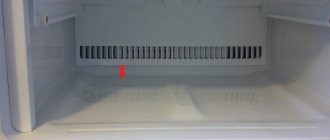Causes of problems with water intake
In a situation where water does not flow into the toilet tank, you need to pay attention to this problem and try to fix the breakdown as quickly as possible, otherwise the plumbing fixture can completely fail at any time and will need to be replaced.
In order not to pay money for the services of specialists or not to purchase new equipment, you can try to cope on your own with the fact that the toilet tank does not fill or it does not happen quickly enough. But first you need to find out why the breakdown occurred.
You should not immediately completely disassemble the device; you must first make sure that there is water in the water supply system. According to professionals, about 40% of water drainage problems occur due to the fact that it does not enter the device. First, you should find out whether there is a water supply in the house or riser, and only then look for the reasons why water is not filling the toilet tank.
When the system is full and the pressure in it is sufficient, but the device is not working, this indicates the presence of another type of breakdown. To be completely sure that everything is in order with the water supply, it would be best to talk about this topic with the neighbors living in the apartments above or below.
Problems with plumbing drainage occur when:
- The float is in the wrong position. This malfunction causes water to poorly fill into the toilet tank. Sometimes the toilet tank leaks for this reason, which is very unpleasant. This should be checked first, since the float can block and leak fluid in different positions.
- The water supply hose is clogged or damaged. Such malfunctions lead to a slow flow of water from the system, and sometimes to its complete shutdown.
- Sand or grains of rust have accumulated in the place where the pipe connects to the device or in the filter. This circumstance may explain why water is drawn slowly into the toilet tank. Typically, blockages occur as a result of repairs to utility lines.
- The exhaust valve is damaged, clogged or broken. This is one of the possible reasons for the occurrence of such a problem as water does not fill into the toilet tank.
Failure of plumbing equipment is caused by over-tightened structural fasteners - nuts, bolts and other elements. For this reason, you need to carefully check all connections, carefully turning them to make sure that everything is assembled securely and at the same time not overtightened.
It is necessary to make sure that there is no plaque or mucus on the plumbing components, since their presence may result in damage to the device.
Mechanism and principles of operation of the system
Technically, the product is a container with 2 (or 3) openings for supplying and draining liquid, contains two mechanisms:
- inlet valve;
- shut-off valves.
The water supply and drainage components are connected to each other by a float, which is involved in the process of emptying and subsequent filling of the tank.
The equipment operates according to the following scheme:
- while the water level in the tank decreases, the buoy is simultaneously lowered (air holds it at the top);
- Having reached the lower limit, it opens the water valve and begins to rise until the tank is filled, then stops further flow of liquid.
Filling occurs through a flexible hose. The process can be carried out through a hole located:
- on the side (on the left or right side) - the float element is fixed at the end of a horizontal lever connected to a ball valve;
- below - the displacer is docked with a vertical rod built into the liner.
The drain circuit performs two tasks:
- prevents accidental flushing into the toilet (closes the outlet until the button is pressed);
- protects the tank from overflowing (using an overflow tube), regulates the pressure when draining.
The system can be made in the form of a lever or a pneumatic chamber - their activation leads to the emptying of the tank.
Models with one or two keys are common and popular. The single version is designed to discharge all the liquid; double versions discharge it either entirely or in half. Some products have a built-in combination button that combines both options (the amount of water used depends on the depth of pressing). This allows for significant savings on water resources used.
Before repairing a toilet cistern, you should understand the general principle of its operation and have a good understanding of the device from the inside.
Tank drain device
Today there is a large selection of different designs for draining water into the sewer, but they all have the same mechanism and principle of operation. The main components of such structures are a device for collecting water and for flushing it into the toilet bowl. To flush the tanks, there is usually a button or lever. It may be located on the cover or side of the device.
The flush cistern is sometimes installed at a certain vertical distance from the toilet. In this situation, the container is connected to the plumbing using pipes. This type of design allows you to increase the flow of flushed water.
In some models, the elements of the sewer system for drainage are hidden behind a special decorative screen or combined in one design with a bowl. At the same time, no matter what configuration the drain tank has, its structure remains unchanged.
Toilet cistern
The main functions of the product are as follows:
- water is drawn into the system to a certain mark or level; malfunctions in the parts of this device are often the reason why water is not drawn into the toilet tank;
- The water should be drained into the bowl in full or partially.
The main points of operation of the device while filling it with water:
- In order for water to resume flowing into the tank after draining, the float, which is fixed at the end of the lever, must work effectively.
- After pressing the button, the float lowers, opening a special hole for water supply.
- When water completely fills the system to the desired level, the float rises again and closes the fluid inlet channel.
Today they produce devices in which water is supplied from below. This is very convenient because it significantly reduces the noise level when filling the tank. However, such designs have a more complex structure and are much more expensive than conventional budget analogues.
Old-style devices used a similar drain principle. The hole for draining water was covered with a rubber part like a pear or a special valve. The lever, protruding beyond the structure, was connected to the body using a chain. To flush, you had to press the lever and it would open the drain hole.
Cistern. Inside view
If you are wondering why water is not filling into the toilet tank or is filling very slowly, first of all, you need to check this component for a malfunction. Sometimes a significant amount of liquid simply flows out through a drain that is not tightly closed. Later in our article we will look at ways to solve this problem.
Such designs are simple; they do not have a large number of small moving parts. If this system breaks down, you can easily repair it yourself. The toilet tank in your bathroom will work like new again.
However, newer toilet models have a different type of locking mechanism. Such fittings have the function of adjusting the flushing force or the volume of drained water. Externally, the device is a double button, each half of which allows you to release water with a different pressure.
Double Button Flush Parts
Float misalignment repair
If the toilet does not fill with water at all, this is unlikely to happen as a result of the float being misaligned. But in the case when it enters the system, but not in the required volume, then the float should be checked for its correct location.
To do this, you need to open the lid - under it you will see water, with a mechanism located in it and a lever, at the end of which a special buoy is attached - a float. It is this part of the device that is responsible for drawing water to the required level, after which it closes the inlet valve. It also happens that the toilet leaks after flushing; this may also be due to the float.
In case of misalignment, it begins to prematurely interrupt the supply of liquid, which ends in the inoperability of the device. The displacer is carefully placed by hand into the required position - after this, the operation of the system should be restored.
Internal structure of the toilet
Knowledge of the internal structure of the toilet will help you quickly find the reason why the toilet does not fill with water. There are 2 important units in the drain tank: the first is responsible for collecting water, the second is for draining liquid. The water is released after pressing a button or acting on a special lever, which are located on top of the tank on its lid, or on its side.
Installation of the tank structure is carried out in 2 ways:
- in a vertical position on the place of the toilet indicated in the instructions, on its shelf. Pipes are used to connect the cistern;
- The drainage tank and sewage system are located behind the decorative screen. Connections are made by pipes to the bowl of the sanitary ware.
The inside of the tank must perform 2 functions:
- When all internal components are working correctly, the container is filled with the required amount of water. If the toilet capacity does not fill, this is the cause of the breakdown.
- The water is completely or partially drained into the toilet bowl.
Despite the variety of designs for draining liquid into the sewer system, their operating mechanism is similar to each other.
The mechanism of operation of the tank for draining:
- There is a mark on the inside of the tank. Liquid is drawn into the container to its level. The collected amount of water is recorded by a float;
- Water is released after pressing a button or pressing a lever. When the amount of liquid decreases, the float sinks to the bottom. At the same time, a special hole opens for water to enter the tank;
- the water level in the tank rises along with the float to the previous level. At the same time, the hole for supplying liquid from the system is closed.
There are models of toilets with bottom water supply on sale. The design is more complex than the standard model and the price category is higher. Water is poured into such a tank quietly.
Clogged water supply valve to the toilet tank
When the toilet tank does not fill with water, despite the fact that it is present in the water supply, the cause of the breakdown may be a clogged inlet valve. This occurs as a result of the accumulation of debris, sand, rust and other contaminants, including plaque and mucus.
It is advisable that the blockage be removed in a timely manner - such problems should be dealt with by regular cleaning and rinsing of the mechanism. Timely prevention will ensure that a situation does not arise when the toilet does not fill the tank with water.
The breakdown is repaired in a certain sequence:
- Turn off the liquid supply to the tank. Typically, houses and apartments have a common tap that can completely shut off the flow of water. It's being twisted.
- The underwater hose attached to the tank is unscrewed and removed. It is necessary to proceed with extreme caution, since sediment from the water supply system can make the disconnection process difficult.
- A visual inspection is carried out to find the place where the blockage has accumulated, after which it is cleared with a flexible steel wire.
- Release the water supply tap slightly so that the remaining debris and dirt are washed out under pressure.
After the blockage has been cleared, in order to complete the process of eliminating the problem associated with the fact that the drain tank does not take in water, all that remains is to carefully twist the entire structure in the reverse order, not forgetting the need to carefully tighten all the nuts, but, most importantly, not pull them over.
Then check the level of water intake and, if necessary, adjust it using the bend of the lever and the location of the float.
Step-by-step instruction
First, it is necessary to eliminate the incorrect position of the valve or float. These parts may move slightly. If there is a misalignment, you should remove the lid from the toilet tank and carefully adjust these elements by hand, putting them in place. Often, performing these simple steps is enough to fix the problem.
Adjusting the elements of the cistern
If this does not help, minor repairs will be required.
Before repairing the tank, turn off the tap water in the system. Then perform the following steps:
- Using an adjustable wrench, unscrew the hose connecting the water supply tube to the tank and check the free flow of liquid.
- Remove existing blockage. This must be done when water passes through the hose but does not fill the tank. Contamination may be in the pipe or its junction with the drain system. This area is cleaned with a nail or any other long sharp object.
- After this, the flexible hose is attached back to the tank and checked whether the container is filled with water.
Float repair
Malfunctions of this part, as a rule, are of two types: the float does not supply water to the system at all or does not completely block its flow. Problems are usually caused by either the float itself or the valve. Float designs may vary. They produce models of plumbing fixtures in which this part is hollow inside.
There are also floats that resemble a cup turned upside down. The first option much more often stops functioning normally, since water can get into it. In this case, the situation can only be corrected by completely replacing the locking mechanism. The second version of the float is somewhat more convenient to use, however, over time, dirt accumulates on it and it can also fail. The problem is easy to fix - just rinse this system component well.
Float in the cistern mechanism
The shut-off fittings or valve, which restricts the water supply, ceases to cope with its functions due to contamination of the membrane or holes that allow water to pass through. To repair these parts, the float is disassembled. To remove the membrane, you need to remove the protective cap by turning it slightly.
To adjust the position of the float, you need to perform a number of simple manipulations. You need to fill the drain tank and monitor the level to which the water reaches. The liquid should be located three to four centimeters below the side openings of the tank. Some drainage systems do not provide such clearances. Then pay attention to the body of the drain device - the liquid should lightly cover it.
Float repair and adjustment
You can get the required water level in the tank by raising or lowering the float. By raising this element of the system, you can increase the mass of water collected, and by lowering it, you will reduce the amount of liquid. Adjustment is carried out using a special screw or rail (the second option is often found in inexpensive plumbing models).
The troubles that arise due to a breakdown of the flush mechanism mainly boil down to the continuous flow of water into the toilet bowl. There are several reasons for such problems:
- Incorrectly adjusted overflow. Sometimes the tube drops lower than required and the float collects too much water. The overflow tube is manually adjusted by simply lifting it. Sometimes it is enough to slightly tighten this part and the leak is eliminated. In some cases, additional adjustment of the position of the overflow elements may be required.
- Faulty valve. Sometimes the rubber valve stops holding water. It may become clogged or dry out.
Disassembled tank valveIn order to solve this problem, the mechanism is disassembled. In this case, the drain tank does not need to be removed. The drainage device can be easily separated into two halves, thus giving you access to the drainage hole and the valve itself. These parts need to be cleaned, then the mechanism must be reassembled and its functioning checked. Sometimes to eliminate such a malfunction it is necessary to replace the membrane.
A leak can also occur at the junction of the tank and the toilet. Such problems can be eliminated by replacing all gaskets and rubber seals for fasteners or screws. To do this, the tank reservoir must be removed.
Dismantling and repair of the drain tank
If a breakdown occurs in the parts of the locking mechanism, then it is necessary to replace all failed elements or buy new shut-off valves.
As you can see, the cistern design of different toilet models is the same and has a fairly simple operating principle. If you understand the mechanism of action of all parts of the drain system, carrying out routine repairs will not be difficult. You can easily troubleshoot problems yourself. It is only important to notice the breakdown in time and solve the problem of a faulty tank.
The device of the drain tank. Drain tank. Inside view Hoses for supplying water to the tank Adjusting the elements of the flush tank Float in the flush tank mechanism Repair and adjustment of the float Dismantling and repairing the flush tank Toilet flush tank Parts of the flush device with a double button Single-button flush tank Parts of the toilet flush mechanism Disassembled tank valve READ MORE: Why dark spots appeared on the stems of Zamioculcas
Damage to the supply hose
If you need to find out why water is not filling the toilet, be sure to check the underwater hose through which the liquid moves into the tank. This is a reason that property owners also often complain about.
After some time, the manufacturing materials and components for plumbing fixtures may wear out and, as a result, fail, and then such a problem as water not flowing into the toilet cannot be avoided.
The hose is replaced as follows:
- Depending on the design features of the water supply system, turn off the general water inlet valve to the housing or completely to the riser.
- Unscrew the supply hose and inspect it. If, during a visual inspection, damage is found in the form of cracks or holes, then it needs to be replaced, otherwise the problem of why the toilet does not draw water into the tank cannot be solved.
- When there are no visible imperfections on the hose, it is lowered into a previously prepared container and the general tap is slightly released. Leaks can be seen by the water that appears in them.
- The underwater hose is replaced with a new one, and you can use this plumbing equipment.
Sometimes, if water does not flow into the toilet flush cistern, you have to change the tee-joint, but to do this, they shut off the water supply not only to the riser, but to the entire house.
Breakdowns and their elimination
So, the flush has stopped working and water is not flowing into the toilet tank, what should you do?
Even without knowing the reason, you should take the following tools:
- Any sharp object.
- Adjustable wrench or pliers.
Reasons why water does not fill into the tank:
- No water supplied.
No matter how trivial it may sound, check the availability of water in the house. The tap may be closed and the mechanism of the drain tank has absolutely nothing to do with it.
- The float is skewed.
Check that the valve or float is positioned correctly. It will be enough to correct the float so that it returns to its original place. If this does not solve the problem, the problem is not with the float.
- The pipe is clogged.
A blockage can occur when replacing a pipeline with a temporary shutdown of water. In this case, the composition of the water changes noticeably and even with the naked eye you can see the presence of rust. To check the connection to the tank for clogging, you must first turn off the water supply to the tank and only then release the hose, the water supply system and the connecting tank. Now you should check the water supply through the hose. If the water does not flow through, the cause is a blockage. The connection area should be carefully cleaned using a long, sharp object.
- Rust in the filter.
Sometimes the water supply may stop due to scale getting under the hose nut, as a result of which the pressure drops, and after a while it stops altogether. To solve the problem, you need to remove and wash the filter.
- Float is dirty.
If you have an “economy” class inlet valve installed, the float will very quickly become covered with mucus and plaque and stop moving. Here it is necessary to remove the entire float mechanism and clean the rubbing surfaces.
- The exhaust valve is worn out.
If you installed the tank a long time ago, the float mechanism could simply wear out. In this case, it is necessary to replace the exhaust valve. But whether you can complete this task yourself is up to you to decide.
- Leak.
In this case, the water does not have time to accumulate in the tank, as it immediately flows into the toilet itself from the tank. It is because of this that unsightly yellow smudges form on the inner cavity of the bowl. Increased water consumption will result in additional costs. To solve this problem, it is necessary to replace the siphon membrane, which, due to wear, has lost its hermetic ability to close the hole. Rinse the water from the tank, remove the siphon, replace the membrane with a new one and secure the siphon in its original place.
Removing a blockage in the drain device
If the drain from which liquid pours into the toilet becomes clogged, problems also arise, but this does not affect the flow of water. It will enter the tank, raise the float to the required level, but the drain mechanism will not work.
Troubleshoot this way:
- remove the cover and disconnect the drain button;
- inspect the outlet valve from below, which opens when you press the water release button;
- If dirt is found, remove it by hand.
When the debris is not visually visible, the cause of the malfunction may be the tube connecting the tank to the plumbing. It should be remembered that mucus and plaque accumulate on the walls of the device and internal surfaces, which must be removed regularly.
Household chemicals, such as "Mole", for example, cope best with the cleaning task. They must be used with extreme caution and care, since the substances contained in their composition can harm the skin and mucous membranes of the respiratory tract. You must act in accordance with the attached instructions.
Other cases of breakdowns when water does not fill the tank
There are other situations when water does not flow into the toilet tank. Sometimes, when installing plumbing fixtures, the parts are twisted too tightly together, for this reason they cannot perform their functions correctly. In this case, all components should be disassembled, cleaned and reassembled.
Experts recommend: to avoid problems with poor water flow into the toilet tank, take preventive measures at least twice a year and thereby maintain the mechanism in good working order for a long time.
It should be remembered: if you neglect such a problem for a long time that water does not fill well into the toilet, it still will not resolve itself, but will only worsen.
Postponing the repair of plumbing equipment for an indefinite period of time always results in serious problems, which cannot always be eliminated. As a result, both the tank and the toilet will need to be replaced, which will require considerable financial costs.
In addition to the fact that a faulty plumbing fixture makes living conditions in the apartment less comfortable, it can completely break down at the most unexpected moment and flood the neighbors. Therefore, if breakdowns are detected, they should be repaired as quickly as possible.
Perhaps the reason why the toilet does not fill with water is that the inlet valve was initially defective, but this became evident during operation, especially when the water supply is not of high quality.
In addition, plaque accumulates on the surface of both the valve and the drain mechanism, which prevents them from operating correctly. For a home craftsman who has never done plumbing work, without professional knowledge, it will be difficult to figure out why water is drawn into the toilet tank slowly or does not flow at all. Perhaps the best solution would be to call a plumber.
Tank repair technology
Water enters the drainage system from a water pipe, passing through a flexible hose. After the tank is completely filled, the rising float closes the membrane and blocks further access to liquid. When you press a button or release a lever, the rubber bulb moves up and water pours out, washing the bowl.
READ MORE: Fatsia 45 photos caring for an indoor flower at home, propagation of Japanese fatsia by seeds, diseases and pests of plants Why leaves dry and fall off
It is these parts that usually fail, and then water does not flow into the toilet tank or the device constantly leaks. In this case, it is not at all necessary to immediately prepare to replace the plumbing product. Often it is enough to simply buy a new hose or other structural element.
Hoses for supplying water to the tank
In order to repair a faulty drain tank, you need to prepare the following tools:
- a sharp and long rod or nail;
- adjustable wrench.











